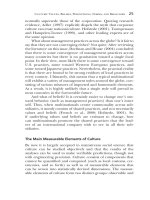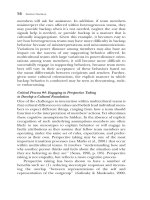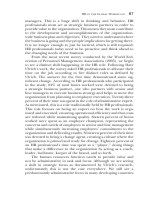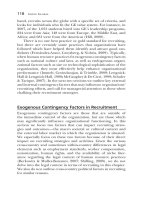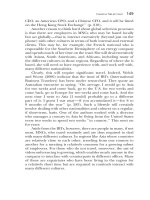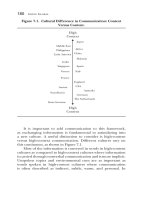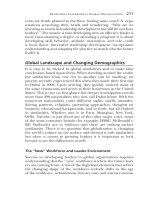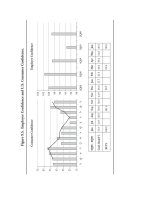Going Global Practical Applications and Recommendations for HR and OD Professionals in the Global Workplace_5 pot
Bạn đang xem bản rút gọn của tài liệu. Xem và tải ngay bản đầy đủ của tài liệu tại đây (496.98 KB, 31 trang )
118 Going Global
hand, recruits across the globe with a specific set of criteria, and
looks for individuals who fit the GE value system. For instance, in
2007, of the 1,053 students hired into GE’s leadership programs,
224 were from Asia; 148 were from Europe, the Middle East, and
Africa; and 681 were from the Americas (Hill, 2008).
There is no one best practice or gold standard for recruiting,
but there are certainly some practices that organizations have
followed which have helped them identify and attract good can-
didates (Fern´andez-Araoz, Groysberg, & Nohria, 2009). Typically,
when human resource practices fit exogenous contingency factors
such as national culture and laws, as well as endogenous organi-
zational factors such as size or technological sophistication of the
organization, they most effectively help enhance organizational
performance (Immelt, Govindarajan, & Trimble, 2009; Lengnick-
Hall & Lengnick-Hall, 1988; McGaughey & De Cieri, 1999; Schuler
& Tarique, 2007). In the next two sections we outline key external
and internal contingency factors that may influence organizations’
recruiting efforts, and call for managerial attention to these when
chalking their recruitment strategies.
Exogenous Contingency Factors in Recruitment
Exogenous contingency factors are those that are outside of
the immediate control of the organization, but are those which
may significantly influence organizational functioning. In this
section we focus two factors that can impact recruiting strate-
gies and outcomes—the macro societal or cultural context and
the external labor market in which the organization is situated.
We especially focus on these two factors because of their direct
impact on recruiting strategies and activities. Given the various
cross-country and sometimes within-country differences in legal
elements such as employment standards, worker compensation,
unionization, human rights, and the availability of niche liter-
ature regarding the legal context of human resource practices
(Berkowitz & Muller-Bonanni, 2007; Shilling, 2008), we do not
delve into the legal context in terms of recruiting in this chapter.
We also do not outline cross-country political factors in recruiting
for similar reasons.
Recruitment in a Global Workplace 119
Societal or Cultural Context
Managerial assumptions and work values are shaped by the soci-
etal and national cultures in which they operate (Laurent, 1986)
and human resource practices may not always trump sociocul-
tural boundaries of different countries (Mendonca & Kanungo,
1996; Sparrow & Budhwar, 1997). Thus, although the ‘‘what’’
question in human resource philosophy may be universal (for
example, effective employee recruitment), the ‘‘how’’ question
may be culture-specific (for example, criteria and sources of
recruitment) (Tayeb, 1995; 1998). This is especially the case
because historical legacies, social stratification, educational sys-
tem, and pressure groups all have their origins in national culture,
and exert their own influences on work values, attitudes, behav-
iors, and thus on organizational human resource policies and
practices (McGaughey & De Cieri; 1999; Tayeb, 1995; 1997).
Overall, criteria as well as methods and sources of recruitment
may be culture bound.
Managers in individual-oriented or self-oriented countries
may recruit differently as compared with managers in collec-
tive or socially oriented countries (Kulkarni, Lengnick-Hall, &
Valk, 2010). In individually oriented countries, recruitment may
be based more on hard criteria such as competences and skills.
In socially oriented countries, recruitment may be based more
on soft criteria such as social and interpersonal skills, or socially
ascribed status. For example, whereas education and past work
experience may be specific recruitment criteria in the United
States, in Asia or the Middle East a criterion may be whether or
not the candidate belongs to the manager’s ‘‘in-group.’’ Specifi-
cally, managers from mature economies such as the United States
may be individualistic in that their in-group may not include
the workplace (Tayeb, 1995), whereas managers from growth or
developing countries are generally more family- and community-
oriented in that members from the workplace may be viewed as the
in-group (Mendonca & Kanungo, 1996). Although the personnel
function in Asia and the Middle East is becoming more strategic
and objective, networks based on social contacts, caste, and other
social connections still influence human resource policies and
practices. Indians, for example, are relatively more collectivist,
clan oriented, and caste conscious (Tayeb, 1987), and Taiwanese
120 Going Global
and Malaysians are rooted in traditional Chinese values of group
or collective orientation. People in Thailand, China, and Viet-
nam are also known to administer preferential treatment toward
network or in-group members (Zhu, Warner, & Rowley, 2007).
Networks or the collective in-group may also be determined by
religion. A large body of research shows that religion is important
in Islamic countries, particularly in the Middle East. Numerous
studies across countries such as Egypt (Leat & El-Kot, 2007), Oman
(Aycan, Al-Hamadi, Davis, & Budhwar, 2007), Iran (Namazie &
Frame, 2007), United Arab Emirates (Rees, Mamman, & Braik,
2007), and Saudi Arabia (Alsahlawi & Gardener, 2004), to name
a few, indicate that managers may target familiar others based on
religion. The tendency to recruit from the known social network,
some argue, reflects uncertainty avoidance (Leat & El-Kot, 2007),
and a social or collective orientation (Aycan, Al-Hamadi, Davis, &
Budhwar, 2007). This tendency may be reflective of developing
countries in general (Kanungo & Jaegar, 1990), given that there is
generally more uncertainty in developing countries as compared
with mature ones.
Overall, societies that value interpersonal relationships will
gear recruitment efforts to identify candidates that fit the social
network in the organization (Aycan, 2005). This has a direct and
substantive influence on whereandwho managersrecruit. Recruit-
ment may be especially driven by ascribed status driven by familial
and social connections—that is, personal relationships—a situa-
tion that may not be overt or explicit in European organizations
(Budhwar & Khatri, 2001; Sharma, 1984; Sparrow & Budhwar,
1997). In sum, collective or high–uncertainty avoidance cul-
tures may prefer internal recruitment channels, and informal
and network-based recruitment (Aycan, 2005). Considering the
fact that people who live and work in countries described as
‘‘developing’’ or ‘‘growth’’ comprise almost 80% of the world’s
population (Aycan, Al-Hamadi, Davis, & Budhwar, 2007), and this
region is where job growth is currently highest (International
Labour Organization, 2009), the impact of social factors cannot
be overlooked by multinational organizations.
What have organizations done given this situation? Recog-
nizing such regional differences, some organizations, such as
Unisys, leverage a hybrid model to tap into global talent. In a
Recruitment in a Global Workplace 121
hybrid model, each business unit has a recruiting specialist to
fulfill functional roles within that designated unit, but targeted
recruiting strategies are centralized. Thus the process of imple-
menting the recruiting policy is delegated to the local units
which are clearly tuned into local realities (Corporate Leadership
Council, 2006b).
Macro societal aspects also influence what the available labor
pool values, and consequently what organizations should signal
when attracting candidates. For example, whereas candidates in
individually oriented countries such as the United States strongly
value health benefits, this benefit is among the least valued in
Asia and Australia. Recruitment efforts thus have to be tar-
geted. Cendant Mobility, a provider of workforce development
solutions, provides an example from India. Indian employees
have familial obligations and responsibilities that are complex
and often more demanding than a Western notion of family
responsibilities. Indians may be expected to care more for their
extended families (Budhwar, 2001; 2003; Kulkarni, Lengnick-
Hall, & Valk, 2010). This suggests that work-life benefits such as
flexible time-off may be more compelling for attracting candi-
dates in India as compared with elsewhere (Corporate Leadership
Council, 2006b).
So what should global managers do in regard to the macro
social context when recruiting globally? One, global managers
should be trained and sensitized to be aware of the significant
roles that institutions such as family, religion, education, trade
unions, and the state play in shaping employee attitudes and
actions across the world. This awareness will help the managers to
devise appropriate means to handle diversity at the micro level.
Two, managers should clearly describe the jobs for which they
are recruiting so that even if certain regions tap into their social
networks and leverage informal methods, recruitment and hiring
is particular to the job in question. Three, managers must decide
if they want to delegate recruiting to local units, and for which
levels of hiring this delegation is appropriate. Four, managers
should build flexibility into their recruitment strategies to include
and actively signal different incentives and perquisites to cater to
different expectations across the world.
122 Going Global
Labor Market Conditions
The second macro level contingency which directly and signifi-
cantly affects recruiting efforts is the condition of thelabormarket.
The labor market is defined as the general area from which appli-
cants have to be recruited. Various factors such as national and
regional economies, skill and education level of the workforce,
and demographic composition of the labor pool all affect the
labor market. This story gets complicated further when we con-
sider the global labor market. Two types of labor markets influence
recruitment—scarce and abundant labor markets. Scarcity in the
labor market implies that the labor market is tight, and there is low
unemployment. Consequently, organizations have to try harder
to recruit good candidates. Abundance in the labor market, on
the other hand, implies the labor market is loose, and there is
high unemployment (Bohlander & Snell, 2004). It is important
to note, however, that the labor market is different for different
levels within an organization. For example, it is quite possible that
even though there is an abundant supply of available labor for
lower-level positions, recruiting people for strategic positions may
be tough, as that market may be scarce. We first discuss how a
scarce labor market influences recruitment efforts, and then focus
on how an abundant labor market influences recruitment efforts.
Scarcity in the labor market. Consider these examples. The
Cheesecake Factory in the United States attracts and hires over
20,000 people per year, operates more than 110 restaurants, and
is expanding nationally (Dessler, 2008). Infosys attracts and hires
over 24,000 people annually, and is expanding globally. Further, a
depleting talent pool is forcing organizations to incur higher costs
to source the right talent. How can organizations such as these
find good candidates? The solution that most organizations have
adopted is innovation in their recruitment efforts and strategies
(Dessler, 2008; Kossek, 1987).
Organizations can employ one or all of three strategies to
attract candidates in a scarce market—attract candidates through
innovative campus recruiting efforts, create a strong organiza-
tional brand, actively tap ‘‘passive’’ job seekers—and, if possible,
leverage technology for all of the above. The three strategies
are not mutually exclusive (campus activities can help build an
organizational brand) but are discussed separately for tractability.
Recruitment in a Global Workplace 123
In the following, we discuss ways in which various organizations
have successfully implemented the previous strategies. Use of
innovative technologies depends on the technological sophisti-
cation of an organization, and we therefore discuss it in greater
detail in a later section which elaborates on internal contingency
factors.
Creating a strong campus presence. A wide variety of organi-
zations with a presence across the world utilize campus recruiting
heavily to attract bright candidates. We will consider examples
from Ernst and Young (Sullivan, 2008b), Tata Consultancy Ser-
vices Ltd. (Fern´andez-Araoz, 2007), Procter & Gamble (Ready
& Conger, 2007), Valero (Sullivan, 2006c), and Infosys (Birkin-
shaw, 2008). What do these organizations do in common? All four
organizations have created a strong campus presence and have
established robust ties with national or international universities,
or both, for campus recruiting.
Campus recruiting is taken very seriously at Ernst and Young,
and they have created a campus-centric team approach that
includes a coordinating partner, campus recruiter, campus cham-
pion (senior manager), a diversity champion, and they have added
campus recruiting goals into managers’ personal development
plans and performance scorecards. They have strong internship
program ties with over 300 business schools in North America,
and they leverage former interns as campus ambassadors to attract
newer candidates. These practices ensure that 90% of their interns
join them as full-time hires (Sullivan, 2008b). Similar practices are
followed by Infosys (Birkinshaw, 2008).
University recruiting is also a line-led activity at Procter & Gam-
ble, and many senior managers personally lead campus teams at
top universities around the world. To strengthen and solidify
ties with top universities, which are a key source of talent, the
campus team leaders not only lead recruitment efforts, but they
also fund research, make technology gifts, and participate in var-
ious activities such as conducting talks at the campus, or judging
competitions (Ready & Conger, 2007). Valero goes a step fur-
ther in terms of innovative practices in campus recruiting. They
leverage teaching assistants as talent scouts on targeted campuses,
allowing Valero to secure interns and full-time employees prior to
going for formal on-campus recruiting events (Sullivan, 2006c).
124 Going Global
Accenture taps into specific student clubs at elite universities
such as Yale to recruit the brightest from campus (McConnon
& Silver-Greenberg, 2008). Tata Consultancy Services (TCS) has
also implemented a unique recruitment strategy to build strong
campus ties. They have partnered with certain schools to design
specific classes that fit TCS manpower and skill requirements
(Fern´andez-Araoz, 2007).
Overall, campus recruiting not only helps directly in securing
candidates; it also helps indirectly by creating a future pipeline
of candidates based on the recruiting organization’s past actions
and the reputation it builds on campuses from where it routinely
recruits. For example, when recruiting on campus, Motorola
China offers a variety of services to students including career plan-
ning, resume writing, and team-building exercises. As a result, the
organization hires about 250 to 400 interns annually from partner
colleges, of which 60–80% eventually become full-time employees
(Corporate Leadership Council, 2006b). Some organizations tar-
get students even before they get to any university. Organizations
such as Lockheed Martin, Boeing, IBM, and General Electric
undertake various activities to teach U.S. high school students
science, technology, engineering, and math skills. Boeing volun-
teers, for example, teach science with the aid of flight simulators
and a mock space shuttle with wireless computers, and Northrop
Grumman, a leading global security organization, provides 7,000
high school seniors across North America with 17 weeks of ele-
mentary job training. About 6,000 students have found jobs at
Northrop since the program started in 1971 (Reveron, 2009).
Differentiating by creating an organizational brand. Another
strategy that organizations follow to attract candidates is to create
a clear employer brand image. Organizations such as Google, for
example, have been very successful at branding, and consequently
attracting candidates (Sullivan, 2006a) who are attracted to what
is implied by the brand. Organizations follow various methods to
create a brand image by signaling certain positive attributes and
differentiating themselves in a labor market. Branding influences
familiarity and recall ability which in turn positively influence
candidate attention and job application behaviors (Collins, 2007).
The key idea in branding is to make the organization salient in
Recruitment in a Global Workplace 125
the mind of the labor pool, so that when the opportunity arises,
candidates will apply to the organization.
So which recruiting strategies based on branding have orga-
nizations followed to ensure that people sit up and take notice
of them?
Hiring managers at Intel offer podcasts and host Webinars to
explain jobs and opportunities, and answer questions from poten-
tial candidates. This is a low-cost method for building relationships
and it also focuses on a very specific audience that the organization
is trying to target (Institute of Management and Administration,
Inc., 2008). Another low-cost but relatively nontraditional method
to attract skilled workers is what is referred to as‘‘ proximity
recruiting.’’ Toxbox, a next-generation provider of a free ser-
vice that lets you talk with your friends over live video, engaged
in innovative proximity recruiting when Yahoo! was laying off its
employees. Toxbox set up a taco truck outside Yahoo’s campus and
offered affected and other employees hot lunch while also adver-
tising employment opportunities at Toxbox. They could thus tap
into valuable talent from Yahoo! and garner enormous publicity
for their relatively unknown organization (Sullivan, 2008a).
Certis CISCO, the largest auxiliary police force operator in Sin-
gapore, traveled a little farther away from their campus to develop
their brand and recruit candidates. They wanted to attract rela-
tively large numbers of auxiliary police officers and management
personnel to join their growing organization. This was accom-
plished by sending out a ‘‘recruitment bus’’ to travel to the
heartlands. They also organized road shows where they offered
iPods to the first 100 applicants, and set up library talks to reach
out to people who may not necessarily have been familiar with the
force (Lee, 2007).
Organizations across the world have also used visual media to
promote their brand and gain attention of applicants by making
the organization salient in the minds of people exposed to the
media. Donald Trump’s ‘‘The Apprentice’’ and ESPN’s ‘‘Dream
Job’’ are well known. Organizations such as Aviva Life Insurance,
Flextronics Software Systems, LG Electronics, Impetus Technolo-
gies, DNA, Yes Bank, and Denstu have also participated in a
televised recruitment drive. This televised event was hosted in
126 Going Global
India by Naukri.com, in association with CNBC TV 18, a lead-
ing business news and information channel (‘‘The Job Show,’’
2006). Deloitte Consulting also leveraged visual media, and in
2007 invited its employees to create a three-minute amateur film
answering the question, ‘‘What’s your Deloitte?’’ Not only did this
initiative spark widespread interest within the internal community,
it eventually became a great recruiting tool for the organization
(Fugure, 2009).
Finally, to stand apart in a crowded organizational world, some
organizations include the applicant’s family in the recruitment
drive. For example, some organizations pay the expenses for an
applicant’s spouse to accompany him or her on a site visit. This
organizational act suggests to the applicant that the organizational
culture is supportive of work-family issues (Boswell, Roehling,
LePine, & Moynihan, 2003). Overall, these strategies are designed
to make the organization salient in the minds of potential job
seekers.
Actively targeting passive job seekers. AsurveyofglobalCEOs
shows that most organizations start their recruitment process reac-
tively when a position opens, but it is clearly more useful to start
the search process much in advance for all levels of the organiza-
tion. Intuit, a software organization, known for such products as
QuickBooks and TurboTax, carefully starts their search process in
advance of headcount needs. They have created supply-demand
maps for all organizational levels and manage to accurately antic-
ipate more than 90% of their talent needs (Fern´andez-Araoz,
Groysberg, & Nohria, 2009).
However, anticipating need and then targeting the correct
candidate is tougher than it may seem, especially for strategic
positions. In such cases, organizations may actively seek passive job
seekers—people currently employed by other organizations, who
are happy at their current workplace, and aren’t looking actively
for jobs (Chatman, O’Reilly, & Chang, 2005). Consider the case of
Amazon. Amazon’s business model requires the organization to
manage a constant flow of new products, suppliers, and customers,
as well as deliver orders by promised dates. When Amazon needed
a new head for its global supply chain, it recruited Gang Yu, a
professor of management science and a software entrepreneur
who is one of the world’s leading authorities on optimization
Recruitment in a Global Workplace 127
analytics. Of course, this combination of analytical, business, and
relationship skills was difficult to find, and Amazon looked at
nontraditional sources to tap someone who can be seen as a
‘‘passive job seeker.’’ SAS, a software organization, also needs
candidates for niche and state-of-the-art business applications
such as predictive modeling or recursive partitioning (a type of
decision tree analysis). To fill these niche positions, they begin
recruiting up to 18 months before they need to fill such positions
(Davenport, 2006).
Consider yet another example. Chiron, a pharmaceutical orga-
nization, operates in a very tight labor market where only a few
potential candidates exist around the world for certain scientific
positions. Chiron recruiters learn the business specifics from var-
ious business units and try to build relationships with passive job
seeker scientists who are in turn open to talking with someone
who understands their work and business (Corporate Leadership
Council Recruiting Roundtable, 2006).
Passive job seekers can be sought from various places and in
various ways. Cisco recruiters follow innovative recruiting tactics
such as attending garden shows or microbrewery festivals—any
potential places that their target candidates frequent. At one
point Cisco had also rigged its Web site to spot candidates from
rival organization 3Com and greeted these people with a page
that asked them if they wanted a job at Cisco (Kiger, 2003).
Though this may sound like an outrageous strategy, recruiters
also frequent bars where unsuspecting target candidates may
congregate (Sullivan, 2006b).
The other strategy that organizations are following to tap into
key candidates in a tight labor market is to look at the temporary
or part-time labor pool. To target such candidates, organizations
are leveraging niche job boards. Stay-at-home mothers who are
looking for jobs can be recruited through channels such as Work-
ing Mother Magazine, or bluesuitmom.com; temporary workers
can be targeted via channels such as temps.com; retired employ-
ees can be tapped through retiredbrains.com; and finally, diverse
demographic groups can be tapped into through latina.com or
blackcareerwoman.com. Organizations such as United Parcel Ser-
vice (UPS) that leverage a large temporary workforce customize
part of their Web site to target the part-time candidates. For
128 Going Global
example, their Web site showcases employee testimonials in terms
of what the organization has done for the specific demographic
groups, and why it is therefore a good fit for other such can-
didates (Corporate Leadership Council, 2006a). L’Oreal follows
a similar strategy and highlights women scientists on their Web
site to attract other such employees (Institute of Management
and Administration, Inc., 2008). Finally, the U.S. Army uses sim-
ulation video games directed at recruits who are technologically
sophisticated and avid gamers (Sullivan, 2006a).
In sum, scarcity in the labor market can be dealt with by creat-
ing a campus presence, making the organizational brand salient
in the minds of potential candidates, and actively tapping passive
job seekers. In the next section we discuss how organizations adapt
their recruitment strategies when there is abundance in the labor
market.
Abundance in the labor market. At first glance, it may seem like
an ideal situation—organizations have a large pool of candidates
to choose from, but surveys and studies show that finding good
candidates is tough even in times of high unemployment where
the supply from the external labor market is not tight (Dessler,
2008). To make matters worse, many job applicants who are in the
labor market looking for jobs have an incomplete or inaccurate
understanding of what a job opening involves, are not sure what
they want from a position, and do not have insight with regard
to their knowledge, skills, and abilities (Breaugh, 2008). Thus,
abundance in the labor market implies that organizations have to
sift through a deluge of non-matched candidates. What do organi-
zations do in such conditions? There are various strategies—they
cancreatemultipleroundstozeroinontherightcandidate,lever-
age an external skills database if available, leverage employees as
ambassadors to spot and attract talent, and target boomerang
employees.
Creating multiple rounds to zero in on the right candidate.
Consider the sheer number of applicants at Infosys. Every year,
1.3 million candidates apply for a job at Infosys, and about 17,000
are selected. How does Infosys deal with this large number?
Recruiters have created various rounds to zero in on the right
candidates. Online applications are screened carefully, and only
10% of the applicants are invited to take an online test designed
Recruitment in a Global Workplace 129
to measure applicant technical and written skills. This test is
conducted by an external vendor and less than 1% of people
who do well on this test are considered further (Birkinshaw,
2008). Thus, capitalizing on technology allows Infosys to narrow
an immense number of possible candidates down to a more select
and manageable amount.
Leveraging an external skills database.Tosiftthroughthevast
number of applications, industry bodies are also helping organi-
zations. For example, The National Association of Software and
Services Companies (NASSCOM), the chief industry body for the
Indian information technology (IT) and technology services com-
panies, has created a National Skills Registry (NSR), a centralized
database of all employees of the technology services and business
process outsourcing (BPO) organizations in India. Launched in
2006, the NSR contains third-party–verified personal, qualifica-
tion, and career information of IT professionals. Organizations in
the IT and BPO industry leverage this skills database to inform
their recruitment practices.
Leveraging current employees as ambassadors to spot and
attract talent. Cisco is another organization that gets many appli-
cants. To ensure they hire the correct candidate from many
applicants, Cisco follows an innovative strategy by carefully target-
ing ‘‘active job seekers.’’ Cisco noticed that people would click
on their Web site for information about the organization, and
wanted to know more in terms of the work opportunities avail-
able. Cisco created a ‘‘make friends @ Cisco’’ button on their
Web site, and when people clicked on this button, they got a call
from current Cisco employees who talked about their work. A few
years ago, Cisco received 100 to 150 requests per week from appli-
cants wishing to be introduced to a ‘‘friend@Cisco,’’ and 60% of
the people who joined Cisco did so because they had a friend
working there already (Chatman, O’Reilly, & Chang, 2005). Cisco
also relies heavily on employee referrals, and about 55–60% of
its hires in the sales organization are from referrals (‘‘Perfecting
your employee referrals program,’’ Human Capital, 2006).
The Cisco example brings up an important point. Employees
are a good resource in terms of sifting through candidates as
well as attracting candidates (‘‘Perfecting your employee referrals
program,’’ 2006). Employees understand how an organization
130 Going Global
functions and who may be a good fit. Recognizing this, some
organizations have very successfully used employee referral pro-
grams. At Sasken, 30% of the top management level recruiting
is done through referrals, whereas 32% of all hiring is through
referrals. Other organizations leverage their social networks to
spot the right candidates. At Eli Lilly, for example, key new
hires are asked to identify good performers that the organiza-
tion can eventually target. Eli Lilly also hosts ‘‘bring your own
rolodex’’ meetings where senior staff are encouraged to network
with passive but high-value potential candidates. Organizations
can thus develop a large talent pool proactively and much in
advance of actual staffing needs by tapping into networks of
employees (insiders) as well as trusted suppliers, customers, and
former employees (outside-insiders) (Fern´andez-Araoz, Groys-
berg, & Nohria, 2009).
Targeting boomerang employees. The final strategy we discuss
in this section is called boomerang recruiting. Boomerang employ-
ees, also commonly referred to as rehires, are former employees
who return to an organization. Oftentimes, employees leave the
organization only to realize that their ex-employer wasn’t as bad as
they’d thought. At the same time, the ex-employer may want the
same employee back, given her skill set that was developed within
the organization and thus well suited to it. Boomerang recruiting
is cost efficient because of lower costs of retraining such employees
and building their organizational commitment (naukrihub.com,
2009). Organizations such as McKinsey, Microsoft, Deloitte, Ernst
and Young, Booz Allen, and Bain, to name a few, are pioneer-
ing corporate alumni programs to track good employees who
have left the organization and may want to come back (Puri,
2009). Booz Allen Hamilton has gone further, and has created
a dedicated team called the ‘‘comeback kids’’ that has proven
very successful in encouraging former employees to return (Sulli-
van, 2006a).
In sum, abundance in the labor market can be dealt with by
creating multiple roundsofrecruiting,leveraging an external skills
database if available, leveraging employees as ambassadors, and
targeting boomerang employees. In the next section we direct our
attention to endogenous or internal organizational factors that
influence recruitment strategies.
Recruitment in a Global Workplace 131
Endogenous Contingency Factors in Recruitment
Various organizational level or internal factors influence an orga-
nization’s recruiting strategies. In this section we elaborate on
two factors that can have an impact on recruiting strategies
and outcomes: the size of the organization, and its technolog-
ical sophistication. Although various indicators of size such as
sales volume or other performance measures are used, the most
common indicator of size is the number of employees, as this
indicates both current capacity for work and current performance
level (Scott, 2003). In this section we also use the word size to
denote number of employees, as this has a direct relationship with
human resource strategies. Technological sophistication of the
organization implies organizational comfort with leveraging tech-
nology, and this also has a direct relationship with human resource
strategies, especially attracting and tracking candidates. It is quite
possible that large global organizations are also technologically
more sophisticated than small local setups.
Organizational Size
Organizational size influences the structure of departments,
their functioning, and strategies of an organization. As organi-
zations grow, a simple informal model of control through mutual
adjustment and social interactions gives way to more standard-
ized control (Mintzberg, 1979). Human resource strategies and
recruitment practices in particular also become more formal,
bureaucratic, and resource intensive than practices of smaller
organizations (Fisher, Schoenfeldt, & Shaw, 2006). Large organi-
zations can follow two broad strategies when recruiting: formalize
recruiting processes across the organization, and leverage the
internal labor market. This is an especially important point for
large global organizations that can systematically comb their own
ranks to spot and deploy talent where required.
Formalizing recruitment procedures. Formalizing external
recruitment procedures is important because large organiza-
tions are involved in recurring transactions (such as recruiting
many people) and can economize costs per recruit (Bhattacharya,
2008). Recruiting costs of large organizations such as Infosys
can be amortized over many hiring decisions. Further, large
132 Going Global
organizations are more likely to have dedicated recruiters who
are formally trained. Larger organizations are also more likely
to use more screening procedures than smaller organizations
because large organizations have the resources available to design
or acquire (and validate) multiple screening devices such as psy-
chological tests, physical abilities tests, and so forth (Birkinshaw,
2008). Finally, formalization is important as large organizations
face institutional pressures and public scrutiny and are answerable
to multiple stakeholders (Barber, Wesson, Roberson, & Taylor,
1999; Kossek, 1987).
Leveraging the internal labor market. Considering that formal
procedures in recruiting can be seen through previous sections
and examples, this section will focus on recruiting in the large
internal labor market that exists in large organizations. A 2004 poll
conducted by Development Dimensions International showed that
internal recruiting for management positions was at 53% within
the 350 organizations polled. This was an increase from 44% in
1999 (Little, 2007).
Why do (or should) organizations recruit from their internal
labor pool? Recruiting from within has many advantages. It may
be relatively cheaper to attract and hire candidates from within
the organization than outside, it is a great retention tool, and,
finally, a great way to develop and nurture talent (Plemmons,
2009). In fact, a recent report shows that Skanska, one of the
world’s leading construction groups, which has a presence across
19 countries and employs over 60,000 employees worldwide, saved
several million dollars last year by recruiting internally (Resourc-
ing, 2009). Recognizing the importance of recruiting from within,
organizations such as General Electric and United Parcel Service
put great emphasis on developing talent that can be leveraged
in multiple units of the organization when needs arise (Fisher,
Schoenfeldt, & Shaw, 2006).
How do organizations tap into the available labor pool to
fill positions as they open up? Consider the cases of Cisco and
Houston’s M. D. Anderson Cancer Center. Cisco created
and launched a software application called the Pathfinder. This
software, used by about 20% of the organization’s engineers to
change jobs, allows employees to load their r´esum´es into the
system, sift through openings by location, career level, and other
Recruitment in a Global Workplace 133
criteria, and then contact the hiring managers in other business
units directly (Kiger, 2003). When employees self-attract and
apply in some organizations, internal recruiters at M. D. Anderson
actively look at the availability of internal talent and projected
hiring needs, and target key people (Plemmons, 2009). Managers
at ANZ Financial Services (Australia and New Zealand Banking
Group Limited) actively mentor junior colleagues, and between
half to one-third of the financial planners are recruited from dif-
ferent units of the organization (Egan, 2007). Other organizations
such as Merck and the U.S. military have leveraged technology
to spot and recruit internal candidates. These organizations use
human resources information systems such as SAP and PeopleSoft
to tap into the internal labor pool (Bohlander & Snell, 2004).
Organizations endowed with large internal labor markets can
also use a process called job posting and bidding to leverage
internal talent. This process can be as simple as posting an
opening in the cafeteria to putting it up on the internal Web
server. Texas Instruments, Xerox, and Cisco, to name a few of
many organizations, do this quite effectively (Bohlander & Snell,
2004). Overall, size affords recruiters and hiring managers a large
internal pool of talent, and possibly a formalized predetermined
recruitment process that can be used across locations.
Technological Sophistication
The final contingency we discuss in this chapter is the level of orga-
nizations’ ever-expanding technological sophistication. Whether
the organization is recruiting internally or externally, within social
networks or outside, or in tight or loose labor markets, organiza-
tions can effectively use technology to attract candidates. After all,
the world is getting smaller and recruits are sometimes just a click
away (Friedman, 2006). In the sections below we describe how
various organizations have leveraged technology to recruit candi-
dates. We identify three broad recruiting trends in this section:
leveraging social networking sites, deploying creative Internet
technologies, and creating attractive organizational Web sites.
Leveraging social networking sites. Social networking sites
continue to gain enormous popularity and momentum. To target
specific types of candidates, and to broaden their recruitment
134 Going Global
efforts, organizations are increasingly trying to tap into the
large number of people active on social networking sites such
as LinkedIn. Web sites like Orkut, Facebook, and other social
media sites are the new haunting places for human resource pro-
fessionals these days to scout for talent that can deliver results
(Shah, 2007). Technology organizations like Wipro, and Tata
Consultancy Services have started recruiting heavily through social
media networks. Ernst and Young also heavily leverages Facebook
to target students (Sullivan, 2008b). It’s not just the traditional
civilian large organizations that are leveraging social networking
sites to recruit people. The U.S. Central Intelligence Agency, the
U.S. Navy, and the Army are also using Facebook and Twitter
to recruit talent (Bruce, 2007; MSNBC report, 2009). In fact, a
recent survey by Development Dimensions International showed
that 25% of recruiters used social networking sites for information
about candidates, and 52% of them have used online informa-
tion to make selection decisions (Recruiter, 2009), a trend that is
likely to continue considering the growing millions of active and
passive job seekers that throng such Web sites.
Along with organizations, professional head hunters across
the world are also making social networking sites a part of their
recruitment strategy, and are setting up dedicated resources to
sift through these sites for global recruiting (CyberMedia, 2007;
Sachitanand & Bhattacharya, 2008). LinkedIn is becoming such
a popular recruiting source the world over that professional
recruiters are demanding the same full access that organizations
have in order to have access to more candidates (Goodfel-
low, 2008).
Deploying creative Internet technologies. Organizations are
also increasingly using creative technologies to spot and attract
candidates. Some organizations are using the Web site X-raying
technique to access the passive talent pool. This technique allows
recruiters to see all pages on an organizational Web site that are
not protected by a firewall. X-rays can be done using the advanced
search feature on Web sites such as Google or Hotbot. Another
technique used by organizations is called Web site flipping. Flip-
ping allows recruiters to find all Web pages linked to a given Web
site. For example, recruiters can access individual home pages
that are linked to organizational Web sites. Such cross-linked sites
Recruitment in a Global Workplace 135
can yield valuable passive candidate information. One has to keep
in mind though, that such techniques are not legal throughout
the world.
Yet another technique to get access to job seekers is using
name-generating software. This software can be purchased and
allows recruiters to sift through the Internet to generate names,
profiles, and resumesofindividualsmeeting the search parameters
specified by the recruiter. Intel, in 2004, worked with a vendor to
create such customized software. This software ‘‘crawled’’ through
a list of pre-programmed sites to access very specific types of candi-
dates (Corporate Leadership Council and Recruiting Roundtable,
2006). Valero also automated part of their recruiting efforts and
programmed ‘‘Web spiders’’ to crawl, retrieve, and upload can-
didates into their internal applicant tracking system based on
both current and projected needs (Sullivan, 2006c). Wachovia,
on the other hand, paid for this service instead of developing
one in-house. Various vendors such as ZoomInfo, LinkedIn, and
SearchExpo provide this service for a fee. Other technology-savvy
organizations such as Microsoft encourage and actively leverage
recruiter and employee blogs. Such blogs can be used to target
passive job seekers who are surfing the net. They can be used to
build a relationship with the potential employee as well as create
an organizational brand.
Creating attractive organizational Web sites. The final trend
we discuss is how organizations can leverage their own Web site
to attract candidates. Skoda Minotti, for example, uses a rather
innovative way to attract applicants. Their Web site hosts a game
similar to ‘‘photo audit,’’ where players spot differences in pho-
tos within a given time and have their scores displayed in a
competitive fashion against other players. Potential applicants
from various campuses, who are playing the online game, get
ranked against each other and can see scores of others from
their schools. High scorers are given rewards. This increases Web
traffic to Skoda’s site and gives Skoda a database of potential
hires (Ebenstein, 2008). Skoda Minotti and The Cheesecake Fac-
tory both use a promotional recruitment video on their Web
sites that explains how the organization runs, how people are
such a key asset, and how the potential recruit will enjoy work-
ing for this great organization. For organizations that cannot
136 Going Global
host videos on their own Web sites, there are other cyber places
such as VlogYourJob.com. VlogYourJob.com is the United King-
dom’s first online video recruitment Web site, created by Indigo
Red, a U.K based recruitment consultancy. This Web site encour-
ages organizations to post vlogs—online short videos—as job
advertisements. It also allows recruiters to give potential candi-
dates a taste of what it’s like at the organizations by posting a
video about their working environment (Marketing Week, 2007).
Thus, organizations that have technological sophistication can
leverage both in-house and externally developed technologies to
recruit.
Conclusion
We defined recruiting as a process of finding and attracting the
right candidates and encouraging them to apply for certain posi-
tions. We drew upon recruitment research and organizational
examples to outline various contingencies that managers should
consider when undertaking recruitment initiatives. So what does
all this mean for your own recruiting efforts? How can you create
an effective recruiting strategy in your organization? As outlined
in Table 5.1, we especially argued for the importance of the macro
sociocultural context and the external labor market as the two
key exogenous factors that have an impact on recruitment. We
also pointed to the importance of organizational size and evolving
technological sophistication as the two key endogenous factors
that affect recruitment. For each of these contingencies, we have
distilled lessons based on organizational theory and examples. For
instance, when discussing the social context, we have argued for
the importance of sensitizing and training global managers about
different values and expectations across the globe, and of creating
clear job descriptions that can be implemented irrespective of
where the managers recruit from. Further, on the topic of the
external labor context, we have highlighted the importance of
creating salience in the minds of potential applicants and tapping
passive candidates in a scarce labor market. In terms of an abun-
dant labor market, we have pointed out the importance of creating
multiple rounds of recruiting, leveraging external databases, inter-
nal employees, and targeting ex-employees. We have argued that
Recruitment in a Global Workplace 137
large organizations can formalize procedures and tap the internal
labor pool. Finally, technology can be leveraged to attract candi-
dates. Specifically, organizations can leverage social networking
sites, deploy creative Internet technologies, and create effective
and attractive organizational Web sites.
Overall, we recognize that no two organizations are the same,
and contingencies and recruitment strategies differ per organiza-
tion. Although there is no magic formula for recruiting, and some
of these techniques may force you to think outside the box, the
benefits of charting a well-defined recruiting strategy are clear.
References
Alsahlawi, K. A., & Gardener, E. P. (2004). Human resource and eco-
nomic development: The case of Saudi Arabia. Journal of Third
World Studies, 21, 175–190.
Aycan, Z. (2005). The interplay between cultural and institutional/
structural contingencies in human resourcemanagement practices.
International Journal of Human Resource Management, 16, 1083–1119.
Aycan, Z., Al-Hamadi, A. B., Davis, A., & Budhwar, P. S. (2007). Cultural
orientations and preferences for HRM policies and practices: The
case of Oman. International Journal of Human Resource Management,
18, 11–32.
Barber, A. E. (1998). Recruiting employees. Thousand Oaks, CA: Sage.
Barber, A. E., Wesson, M. J., Roberson, Q. M., & Taylor, M. S. (1999).
A tale of two job markets: Organizational size and its effects on
hiring practices and job search behavior. Personnel Psychology, 52,
841–867.
Berkowitz, P., & Muller-Bonanni, T. (2007). International labor and employ-
ment law: A practical guide (International Practitioner’s Deskbook Series).
Chicago: American Bar Association.
Bhattacharya, S. (2008). From talent crunch to cash crunch. Business
Today, 17, 126–129.
Birkinshaw, J. (2008). Infosys: Computing the power of people. Business
Strategy Review, 18–23.
Bohlander, G., & Snell, S. (2004). Managing human resources. Mason, OH:
Thomson/South-Western.
Boswell, W. R., Roehling, M. V., LePine, M. A., & Moynihan, L. M. (2003).
Individual job-choice decisions and the impact of job attributes and
recruitment practices: A longitudinal field study. Human Resource
Management, 42, 23–37.
138 Going Global
Breaugh, J. A. (2008). Employee recruitment: Current knowledge and
important areas for future research. Human Resource Management
Review, 18, 103–118.
Brewster, C., Wood, J., & Brookes, M. (2008). Similarity, isomorphism
or duality? Recent survey evidence on the human resource man-
agement policies of multinational corporations. British Journal of
Management, 19, 320–343.
Bruce, C. (2007). CIA gets in your Face(book). Retrieved on May 9,
2009, from www.wired.com/techbiz/it/news/2007/01/72545.
Budhwar, P. S. (2001) Doing business in India. Thunderbird International
Business Review, 43, 549–568.
Budhwar, P. S. (2003). Employment relations in India. Employee Relations,
25, 132–148.
Budhwar, P. S., & Khatri, N. (2001). A comparative study of HR prac-
tices in Britain and India. International Journal of Human Resource
Management, 12, 800–826.
Charan, R., & Colvin, G (2000). The right fit. Fortune, 141, 226–238.
Chatman, J., O’Reilly, C., & Chang, V. (2005). Cisco Systems: Devel-
oping a human capital strategy. California Management Review, 47,
137–167.
Collins, C. J. (2007). The Interactive effects of recruitment practices
and product awareness on job seekers’ employer knowledge and
application behaviors. Journal of Applied Psychology, 92, 180–190.
Corporate Leadership Council Report (2006a). Part-time employee
recruiting strategies.
Corporate Leadership Council Report (2006b). Recruiting from a global
talent pool.
Corporate Leadership Council and Recruiting Roundtable Report
(2006). Creating a passive candidate recruiting strategy.
CyberMedia India Online Ltd. (2007). Network sites become networking
platforms. Retrieved on February 17, 2009, from www.ciol.com/
News/News-Reports/Networking-sites-become-recruitment-
platform/131008111373/0/.
Davenport, T. (2006). Competing on analytics. Harvard Business Review,
84, 99–107.
Despeignes, P. (2005). Offshoring: A reality check. Fortune,89.
Dessler, G. (2008). Human resource management. New Delhi: Prentice-Hall
of India.
Ebenstein, J. (2008). Hunting for CPAs: Recruiting and retention tactics.
CPA Practice Management Forum, 4,5–7.
Egan, L. (2007). Digging deeper for productivity gains. Money Manage-
ment, 21, 40–41.
Recruitment in a Global Workplace 139
Farrell, D. & Grant, A. J. (2005). China’s looming talent shortage.
McKinsey Quarterly, 4, 70–79.
Fern´andez-Araoz, C. (2007). Making people decisions in the new global
environment. MIT Sloan Management Review, 49, 16–20.
Fern´andez-Araoz, C., Groysberg, B., & Nohria, N. (2009). The definitive
guide to recruiting in good times and bad. Harvard Business Review.
87, 74–84.
Fisher, C. D., Schoenfeldt, L. F., & Shaw, J. B. (2006). Human resource
management. New Delhi: Houghton Mifflin.
Friedman, T. L. (2006). The world is flat: A brief history of the twenty-first
century. New York: Farrar, Straus & Giroux.
Fugure, B. (2009). Movies with a message: Deloitte employees unleash
their inner director and make the company’s first-ever film festival
a success. Communication World, 40–41.
Goodfellow, C. (2008). Anger over limited access to LinkedIn. Recruiter
News,6.
Guthridge, M., Komm, A. B., & Lawson, E. (2008). Making talent a
strategic priority. McKinsey Quarterly, 1, 48–59.
Hill, C. W. L. (2008). Global business today. New York: McGraw-Hill/
Irwin.
Immelt, J. R., Govindarajan, V., & Trimble, C. (2009). How GE is
disrupting itself. Harvard Business Review,forthcoming.
Institute of Management and Administration, Inc (2008). Best practices:
How top employers are using web-based recruitment technologies
now.
International Labour Organization Report. (2009). Global employment
trends.
Jackson, S., & Schuler, R. (1995). Understanding human resource man-
agement in the context of organizations and their environments.
Annual Review of Psychology, 46, 237–264.
The job show—India’s first televised job hunt by Naukri.com and CNBC
TV. (2006). Human Capital, 9,8.
Kanungo, R. N., & Jaeger, A. M. (1990). Introduction: The need for
indigenous management in developing countries. In A. M. Jaeger
and R. N. Kanungo (Eds.), Management in Developing Countries.
London: Routledge.
Kiger, P. J. (2003). Cisco’s Homegrown Gamble. Workforce, 82, 28–32.
Kossek, E. (1987). Human resources management innovation. Human
Resource Management, 26, 71–92.
Kulkarni, M., Lengnick-Hall, M. L., & Valk, R. (2010). Employee per-
ceptions of repatriation in an emerging economy: The Indian
experience. Human Resource Management,forthcoming.
140 Going Global
Laurent, A. (1986). The cross-cultural puzzle of international human
resource management. Human Resource Management, 25, 91–102.
Leat, M., & El-Kot, G. (2007). HRM practices in Egypt: The influ-
ence of national context? International Journal of Human Resource
Management, 18, 147–158.
Lee, J. (2007). Transforming the HR function from reactive to proactive:
A CISCO case study. Human Capital, 11, 28–31.
Lengnick-Hall, C A., & Lengnick-Hall, M. L. (1988). Strategic human
resources management: A review of the literature and a proposed
typology. Academy of Management Review, 13, 454–470.
Little, D. (2007). Promotional material. Journal of Property Management,
72, 38–41.
Marketing Week (August 16, 2007). Indigo Red unveils UK’s ‘first’
video jobs website. Retrieved on April 8, 2009, from www.mad
.co.uk/Main/News/Disciplines/Media/Digital/Articles/
e5d92fac9b704bd4b5695455450f911b/Indigo-Red-unveils-UK’s-
‘first’-video-jobs-website.html.
McConnon, A., & Silver-Greenberg, J. (2008). Meet your new recruits:
They want to eat your lunch. Retrieved on May 11, 2009. from www
.businessweek.com/magazine/content/08
21/b4085042677127
.htm.
McGaughey, S. L., & De Cieri, H. (1999). Reassessment of convergence
and divergence dynamics: Implications for international HRM.
International Journal of Human Resource Management, 10, 235–250.
Mendonca, M., & Kanungo, R. N. (1996). Impact of culture on perfor-
mance management in developing countries. International Journal
of Manpower, 17, 65–75.
Millikin, J. P., & Fu, D. (2005). The global leadership of Carlos Ghosn at
Nissan. Thunderbird International Review, 47, 121–137.
Mintzberg, H. (1979). The structuring of organizations: A synthesis of the
research. Englewood Cliffs, NJ: Prentice-Hall.
Morris, B., Sellers, P., Schlosser, J., Florian, E., Helyar, J., & Neering, P.
(2004). The real story. Fortune, 149, 84–98.
MSNBC Associated Press, May 1, 2009. Pentagon targets recruits on
Facebook, Twitter. Retrieved on May 9, 2009, from www.msnbc.msn
.com/id/30513702/.
Nakache, P. (1997). Cisco’s recruiting edge. Fortune, 136, 275–276.
Namazie, P., & Frame, P. (2007). Developments in human resource
management in Iran. International Journal of Human Resource Man-
agement, 18, 159–171.
National Association of Software and Service Companies. (2006). 2006 IT
industry Communiqu´efortheAcademia.RetrievedonFebruary10,
Recruitment in a Global Workplace 141
2009, from www.nasscom.in/Nasscom/templates/NasscomSearch
.aspx?cx=018416552530915382824%3Ahxwavbrtgx8&cof=
FORID%3A11&q=IT+industry+Communiqu%C3%A9+for+the
+Academia&sa=Search#858.
Naukrihub.com. (2009). Boomerang employees. Retrieved on April 2,
2009, from www.naukrihub.com/hr-today/boomeranging-
employees.html.
Perfecting your employee referrals program. (April 2006). Human Capi-
tal, 9, 16–19.
Plemmons, P. (2009). Conducting an internal search. Trustee, 62, 26–27.
Puri, S. (2009). Corporate alumni and boomerang recruiting programs.
Retrieved on April 2, 2009, from />corporate-alumni-and-boomerang-recruiting-programs.
Ready, D. A., & Conger, J. A. (2007). Make your company a talent factory.
Harvard Business Review. 85, 68–77.
Ready, D. A., Hill, L. A., & Conger, J. A. (2008). Winning the race for
talent in emerging markets. Harvard Business Review, 86, 62–70.
Recruiter Report (April 2009). Retrieved on August 21, 2009, from
www.recruiter.co.uk/searchResults.aspx?cmd=GoToPage&val=1.
Rees, C. J., Mamman, A., & Braik, A. B. (2007). Emiratization as a
strategic HRM change initiative: Case study evidence from a UAE
petroleum company. International Journal of Human Resource Man-
agement, 18, 33–53.
Resourcing (2009). Skanska’s career growth prospects cuts recruitment.
Resourcing, 11,7.
Reveron, D. (2009). Recruiting trends. US Black Engineer & Information
Technology, 33, 65–65.
Rosenzweig, P. M., & Nohria, N. (1994). Influences on human resource
management in multinational corporations. Journal of International
Business Studies, 20, 229–51.
Sachitanand, R., & Bhattacharya, S. (2008). Working the web. Business
Today, 17, 170–172.
Schuler, R., & Tarique, I. (2007). International human resource man-
agement: A North American perspective, a thematic update and
suggestions for future research. International Journal of Human
Resource Management, 18, 717–744.
Scott, R. (2003). Organizations: Rational, natural and open systems (5th ed.).
Englewood Cliffs, NJ: Prentice Hall.
Shah, R. (2007). Companies start recruiting through social media
websites! Retrieved on February 17, 2009, from www.watblog
.com/2007/11/30/companies-start-recruiting-through-social-
media-websites/.
142 Going Global
Sharma, I. J. (1984). The culture context of Indian managers. Manage-
ment and Labour Studies, 9, 72–80.
Shilling, D. (2008). Complete guide to human resources and the law.Gaithers-
burg, MD: Aspen.
Sparrow, P. R., & Budhwar, P. S. (1997). Competition and change:
Mapping the Indian HRM recipe against world-wide patterns.
Journal of World Business, 32, 224–242.
Sullivan, J. (2006a). 12 best recruiting practices to copy. Retrieved
on February 12, 2009, from www.ere.net/2006/09/25/12-best-
recruiting-practices-to-copy/.
Sullivan, J. (2006b). Recruiting at bars and other places prospects
gather. Retrieved on May 1, 2009, from www.drjohnsullivan.com/
content/view/16/27/.
Sullivan, J. (2006c). Six best practices in recruiting. Retrieved on May 1,
2009, from www.drjohnsullivan.com/content/view/27/27/.
Sullivan, J. (2008a). Recruiting strategies—Proximity recruiting using
a taco truck. Retrieved on February 12, 2009, from www.ere.net/
2008/12/15/recruiting-strategies-%E2%80%93-proximity-
recruiting-using-a-taco-truck/.
Sullivan, J. (2008b). Best practices in recruiting: 2008 ERE award
winners. Retrieved on February 12, 2009, from www.ere.net/
2008/04/07/best-practices-in-recruiting-2008-ere-award-winners/.
Tayeb, M. (1987). Contingency theory and culture: A study of matched
English and Indian manufacturing firms. Organization Studies, 8,
241–261.
Tayeb, M. (1995). The competitive advantage of nations: The role of
HRM and its socio-cultural context. The International Review of
Human Resource Management, 6, 588–605.
Tayeb, M. (1997). Islamic revival in Asia and human resource manage-
ment. Employee Relations, 19, 352–364.
Tayeb, M. (1998). Transfer of HRM practices across cultures: An Ameri-
can company inScotland. The International Journal of Human Resource
Management, 9, 332–358.
Zhu, Y., Warner, M., & Rowley, C. (2007). Human resource management
with ‘‘Asian’’ characteristics: A hybrid people-management system
in East Asia. International Journal of Human Resource Management, 18,
745–768.


